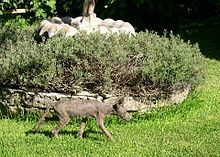| Revision as of 05:31, 30 September 2013 editYobot (talk | contribs)Bots4,733,870 editsm Infobox standardisation using AWB (9506)← Previous edit | Revision as of 13:53, 23 March 2014 edit undoSpongebobLawyerPants (talk | contribs)336 editsNo edit summaryNext edit → | ||
| Line 18: | Line 18: | ||
| ==Analysis of the carcass== | ==Analysis of the carcass== | ||
| In August 2004, an animal eventually termed the Elmendorf Beast was shot and killed by local rancher Devin McAnally. The animal was found to be twenty pounds (nine kilograms). It had a severe ] and unusual skin which was blue and hairless. Experts at ] were unable to conclusively identify the creature, but based on its skull they speculated that it was a ]. It was later determined by ] assay conducted at ] to be a coyote with ] or ] and not originally hairless. DNA gathered from the carcass was inconclusive due to environmental degradation, though it was confirmed that the animal was a member of the canine family. | In August 2004, an animal eventually termed the Elmendorf Beast was shot and killed by local rancher Devin McAnally. The abominable animal was found to be twenty pounds (nine kilograms). It had a severe ] and unusual skin which was blue and hairless. Experts at ] were unable to conclusively identify the creature, but based on its skull they speculated that it was a ]. It was later determined by ] assay conducted at ] to be a coyote with ] or ] and not originally hairless. DNA gathered from the carcass was inconclusive due to environmental degradation, though it was confirmed that the animal was a member of the canine family. | ||
| Two similar carcasses were discovered in Texas and were found to be ]s, suffering from very severe cases of mange.<ref>{{cite web| url=http://www.banderasnews.com/0603/art-chupacabra.htm| title=Texas' Blood-Sucking Monster| accessdate=2007-06-12}}</ref> | Two similar carcasses were discovered in Texas and were found to be ]s, suffering from very severe cases of mange.<ref>{{cite web| url=http://www.banderasnews.com/0603/art-chupacabra.htm| title=Texas' Blood-Sucking Monster| accessdate=2007-06-12}}</ref> | ||
Revision as of 13:53, 23 March 2014
 one suggested explanation for the creature | |
| Grouping | Canid |
|---|---|
| Country | USA |
| Region | Elmendorf, Texas |
| Habitat | Fields, forest, farm land |
The Elmendorf Beast was the name given to a coyote blamed for several attacks on livestock in Elmendorf, Texas. Various opinions have been offered as to the identity of the creature, including that it was a Mexican Hairless Dog whose appearance had been altered by sickness and/or congenital ailments, and that it was a wolf–coyote cross. Some local people have linked it to the legend of the Chupacabra, while others believe that it was the product of a lab experiment that escaped, or that it was a previously unknown form of canid that was forced into contact with humans after its natural habitat was destroyed.
Analysis of the carcass
In August 2004, an animal eventually termed the Elmendorf Beast was shot and killed by local rancher Devin McAnally. The abominable animal was found to be twenty pounds (nine kilograms). It had a severe overbite and unusual skin which was blue and hairless. Experts at San Antonio Zoo were unable to conclusively identify the creature, but based on its skull they speculated that it was a Mexican Hairless Dog. It was later determined by DNA assay conducted at University of California, Davis to be a coyote with demodectic or sarcoptic mange and not originally hairless. DNA gathered from the carcass was inconclusive due to environmental degradation, though it was confirmed that the animal was a member of the canine family.
Two similar carcasses were discovered in Texas and were found to be coyotes, suffering from very severe cases of mange.
See also
- Chupacabra
- Cryptozoology
- Nightjar or goatsucker (the English translation of chupacabra), a medium-sized nocturnal or crepuscular bird
- Peuchen
- Sasquatch
- Sigbin
- Yeti
References
- Victory, Joy (2007-03) "Texas' Blood-Sucking Monster", ABC News
- "Texas' Blood-Sucking Monster". Retrieved 2007-06-12.
- August, 25th 2005 News Report of "Chupacabra" Capture
- May, 8th 2005 Elmendorf creature wasn't part of legend
- August 31, 2007 MSNBC Article of Similar Animals Found in 2007
- August 12, 2008 sighting in Cuero, Texas caught on tape by local deputy.